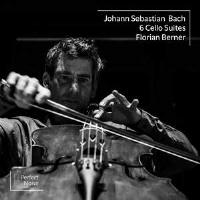Texte paru dans: / Appeared in: |
|
|
Outil de traduction |
|
|
The performance of Bach’s Cello Suites is often surrounded by subtexts that prepare the way for the listening experience, whether we ponder Casals’s ‘discovery’ of the sheet music in a Barcelona bookshop in 1890, Yo-Yo Ma’s mighty Bach Project in 2018 (when he performed the works in 36 different locations on six continents) or Steven Isserlis’s compelling brace of recording and written companion. Here, Florian Berner presents us with six suites divided between two separate locations, and their distinctive stories: a parochial Tuscan village church from lockdown December 2020 and, just over two years later, Bach’s happy hunting ground of Köthen (where the suites were probably composed).
It’s a curate’s egg of a project, not least because the spontaneity of the Italian sojourn is not truly integrated with the more marinated playing of the German leg, and yet the contextual background still presents an interesting idea of how interpretations can evolve and remain ever fluid. Initially, Berner sat in the medieval Chiesa di San Lorenzo with just a cello (having brought his own microphone) and immersed himself in the first three suites over several days. Spontaneity alongside a sense of timelessness and freedom leads to some liberating excursions of colour, rhythm and rhetoric, without a scintilla of the self-conscious reflexes that can easily creep into the performance practice of these pieces. No 1 is the pick of the crop. No 3 is also, largely, a success. The note reveals that Berner started with No 2, this most internally reflective and often fraught essay, and yet his ambition of self-guiding discourse (which Berner compares to Rembrandt’s self-portraits) is short on sustained focus and the tuning is unsettled. After experiencing months without professional engagements, there is a sense that Berner used this suite as the means of getting back up to speed.
Köthen is an altogether different listening experience. The acoustic is complete with a glowing warmth and superb registral balance out of which a measured and questing account of No 4 emerges, and a nobly rendered No 5 with Affekt-laden gestures judiciously scattered through all the movements. If part two of the project is generally more settled than the pandemic-inspired musings of the earlier sessions, the radiance of both the Prelude and the celebrated Sarabande of No 6 is thwarted by more tuning demons. As an example of the spirit peculiar to each location, one wishes that the abandon of the Courante in No 3 from Italy could have infected the relatively po-faced equivalent movement of No 4 from Germany, whose burlesque should surely be unmistakable. Overall, Berner’s serious and inquisitive playing yields some exceptionally impressive movements. Yet this feels more like the diary of multiple engagements with an oeuvre than a formed artistic statement of intent. In his own words: ‘I experienced both recordings as an interim stage, like lingering briefly in a bright clearing while on a long, beautiful walk.’ The listener will need discrimination of what bears regular and repeated listening. |
|




